NEWS
Davidson and the Polydactyl Pups
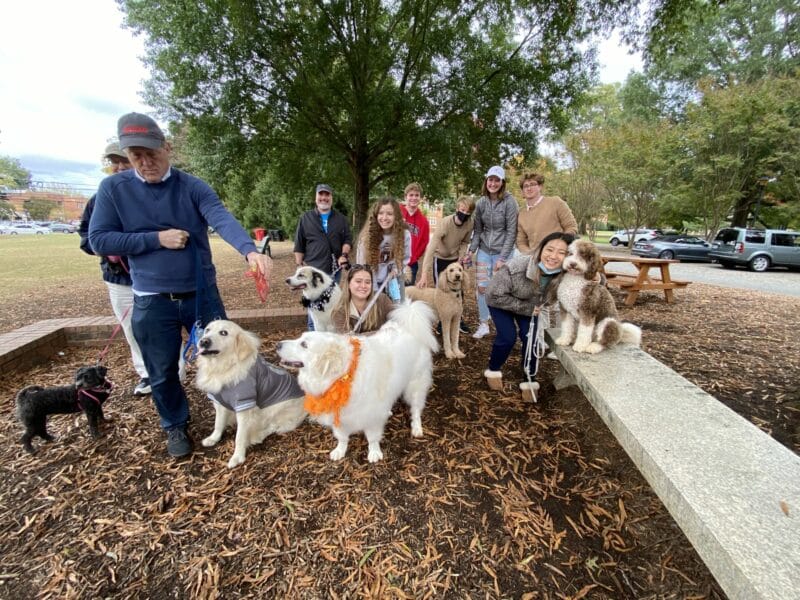
Davidson loves dogs and Wildcats.
Editors’ Note: We want to thank Dr. Rose Stremlau for her help in compiling this article, and for all the work she does on behalf of our canine friends.
Despite being the home of the Wildcats, Davidson is also a very dog friendly community.
There is a good chance that you might have noticed more than a few big white fluffy dogs walking around our town with their humans. Maybe you have been lucky enough to pet them and run your hands through their luxuriant double coats. If you looked closely, you noticed that they have an extra set of rear toes. They are polydactyl and have double-dew claws, an adaptation enabling foot stability in the mountainous region in which the breed evolved to assist shepherds by protecting livestock from predators.
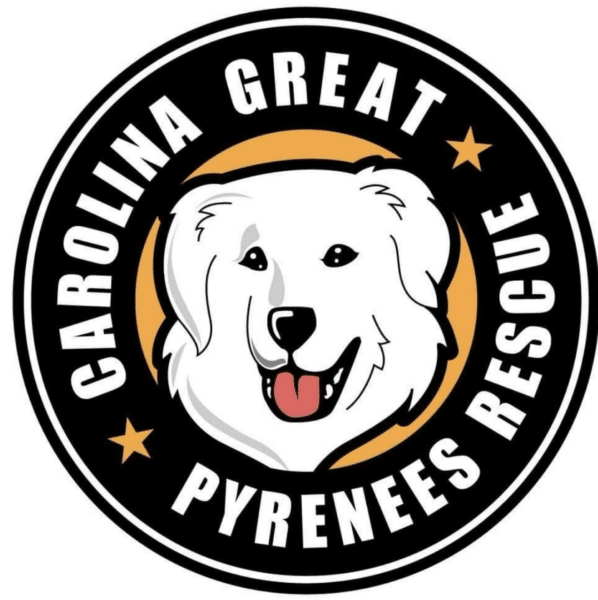 These dogs are Great Pyrenees, or Pyrs for short. One of the reasons that you see Great Pyrenees around Davidson is because over a dozen families in northern Mecklenburg County currently share their homes with dogs adopted from Carolina Great Pyrenees Rescue (CGPR). Although the organization is based out of their president’s grooming and boarding business in Indian Trail, NC, the vice president, webmaster, and two spokesPyrs live here in Davidson: Rose Stremlau, her husband Stephen Herbster, Rio, and Optimus.
These dogs are Great Pyrenees, or Pyrs for short. One of the reasons that you see Great Pyrenees around Davidson is because over a dozen families in northern Mecklenburg County currently share their homes with dogs adopted from Carolina Great Pyrenees Rescue (CGPR). Although the organization is based out of their president’s grooming and boarding business in Indian Trail, NC, the vice president, webmaster, and two spokesPyrs live here in Davidson: Rose Stremlau, her husband Stephen Herbster, Rio, and Optimus.
Established in 1992, Carolina Great Pyrenees Rescue helps abused, abandoned, and otherwise vulnerable or homeless Pyrs and related LGD breeds. “LGD” stands for livestock guardian dogs. Livestock guardians are not herding dogs. Herding dogs are smaller breeds that direct the movement of their flocks. LGDs provide protection and defend vulnerable animals from coyotes, bears, wolves, and other predators. All historic LGD breeds have correlating herding breeds that tend to be smaller and higher energy. Pyrs are known as gentle giants who are independent and loyal in equal measure. On average, CGPR cares for between 125 and 150 dogs from North and South Carolina each year. Many Pyrs come from our states’ public animal shelters, but others are surrendered directly by owners, including those who can no longer care for their pets because of sickness, deployment, unemployment, housing insecurity, and domestic violence. The pandemic and housing crisis have had a particularly stark impact on CGPR: requests for help have skyrocketed.
This all-volunteer organization also advocates for the breed and educates others about the proper care of these working dogs, including those who guard livestock in pastures and those who are “couch guardians,” or pets. They sponsor social events and maintain an online presence because they believe that celebrating the wonderful dogs who share their homes is an important part of rescue. As Stremlau, who manages the group’s social media accounts, regularly says, “Our happy dogs living their best lives are the best advertisement for rescue and the most important tool we have to help more dogs.”
Many of the Pyrs CGPR cares for have compelling stories, and Stremlau tries to tell them. She wants those considering adding a pet to their family to know that some pets come into rescues through no fault of their own but because difficult life circumstances prompted loving owners to reach out to groups like CGPR. Stremlau explained, “Some of the dogs we care for were mistreated, but as many are loved family members. The stereotype that all rescued dogs are rejects with behavior problems couldn’t be more inaccurate. Many of our dogs come from loving homes that can no longer care for them for heart-breaking reasons. Human crises impact pets, too, and while folks with smaller dogs sometimes can find a friend or family member to take in their pet, giant breed dogs like Pyrs are harder to rehome.” At the same time, she emphasizes that people should understand what neglect and abuse look like so that they can identify them in our community and be empowered to act when they can make a positive difference for a vulnerable animal.
On the Monday before Thanksgiving, CGPR became involved with one of the worst cases of animal neglect they have seen in their thirty-year history. An advocate for animals in Randolph County reached out with an urgent case: the night before, animal control there took in an adult female Great Pyrenees who was emaciated, dehydrated, and unable to stand. At 25 pounds, the dog weighed one-third to one-quarter of what a healthy female Pyr should (70-100 lbs.) She was close to death from neglect. As the president of the rescue, Shannon Meehan, arranged for volunteers to pick up the dog and for Carolina Veterinary Specialists (CVS) in Matthews to prepare to receive her, Stremlau notified the organization’s supporters of the situation. Her post on social media was dire, and direct: “Being totally honest. We don’t know if she will make it. We are calling her Merveille (pronounced mer-vay), which is French for a marvel or miracle.”She asked the rescue’s supporters to pray for one and send positive thoughts. The volunteers who drove her to the emergency vet later commented that they weren’t sure she would survive the drive. They kept checking to see if she was breathing and had to carry her into CVS.
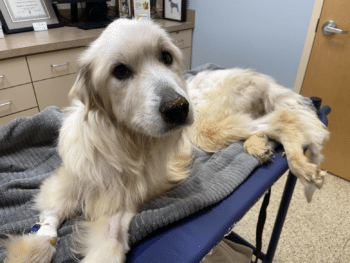
Merveille aka “Miracle”
Over the next several days, the veterinarians and technicians at CVS reintroduced fluids and food to Merveille. She received multiple blood transfusions. Her initial blood tests revealed a severe UTI and pyometra, an infection of the uterus. Surgery was a tremendous risk. Merveille had no body fat, and her organs were already stressed. The likelihood of anesthesia killing her was high. Without a hysterectomy, however, she almost certainly would die of sepsis. The rescue board decided to authorize the surgery, and within a day, they raised the nearly $10,000 required to cover the cost of Merveille’s veterinary care. On the Wednesday before Thanksgiving, Merville had emergency surgery and survived. A miracle indeed. CGPR credits Dr. Lauren Reid, her primary veterinarian, with saving her life.
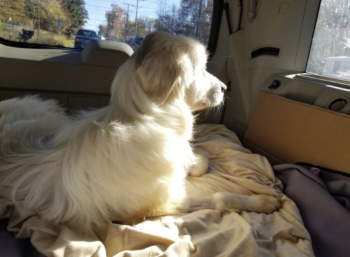
Merveille looked out the back window at Carolina Veterinary Specialists and then turned her face into the light. Perhaps contemplating her bright future.
Merveille showed a survivor’s strength, and on the Saturday after Thanksgiving, Stremlau and Herbster received the call that they could pick her up and bring her back to their home in Davidson to continue her recovery. Merveille remained incredibly weak. While she could stand, she was able to walk only a few steps. Herbster lifted her into their car, and Stremlau cuddled with her on the drive home. As they rode, the sun shone on Merveille’s face as she looked out the window. Stremlau recalls, “I literally cried tears of joy. For nearly a week, we had been hoping for this moment. She was far from out of the woods, but we were at least headed in the right direction.”
Stremlau and Herbster regularly foster medically-challenged Pyrs, and they were prepared for Merveille’s needs. Dogs starved to this degree don’t just lack body fat. They’ve lost muscle throughout their body, and that means they often can’t control their bladder and bowels at first, particularly as their bodies readjust to regular meals. Merveille had a “Pyrpartment” made from an extra large crate and puppy pens waiting for her where she could sleep and eat comfortably while her foster Pyrents kept her and her living space clean. In response to a post on Facebook, several of Stremlau’s colleagues at the college dropped off additional blankets and comforters. Merveille spent her first several days sleeping and waking up only for one of her four meals or six rounds of medication. She could walk the few steps outside to potty, but she often didn’t make it at first. Stremlau jokes that this is why they bulk-buy tarps, gloves, and pet-friendly cleaners. This phase doesn’t last forever, and in fact within days, Merveille was able to control her bodily functions and began to stand and walk on her own.
Throughout this time, Stremlau updated those following Merveille’s story on social media. Stories like Merveille’s are opportunities to educate people about the breed, the labor rescue entails, and the best practices the group recommends. This update from December 12 provides the most insight into Merveille’s progress.
“Merveille continues to improve. She’s taking longer walks, plays inside and in the yard, and enjoys snuggle time on the sofa. She’s every bit as sweet as the pictures suggest, but now that she’s feeling better, Merveille is also experiencing periods of intense anxiety.
We expect this. Many dogs who have been starved search, pace, bark, and otherwise express the doggy version of panic. Some react with snaps and snarls toward humans and other dogs around food, toys, and other desirable items. Merveille is a climber. A “Spider Pyr” who will scale shelves, tables, cabinets, and counters looking for food even though she is being fed well and regularly.
Rather than medicate her, we find ways to let her safely work through it and learn better behaviors. Just like humans, dogs can adapt and heal from trauma. In fact, they often do it much more quickly than we do! When Merveille starts to panic after finishing her meals, we take short walks or go into the yard with her foster siblings so she can direct that energy outside, where she has not been anxious, and be around dogs who are calm. At other times, we work with her inside in spaces where she can’t hurt herself climbing so we can correct the behavior.
We suggest firm and clear correction followed by redirection and positive demonstration of a desired behavior. For Merveille, this means a clear verbal correction, physically removing her from where she shouldn’t be climbing and bringing her where we want her. She wants to be on the sofa with us, and so that’s where we invite her to be instead of anxious. We use our hands gently. There’s no reason to be harsh. Touch, just like with humans, can be healing.
She’s already learning not to climb, and with continued direction and structure, Merveille’s periods of panic will almost certainly become shorter and less intense. She may work past this altogether. That’s the hope.
Healing takes time, structure, patience, and above all, love.”
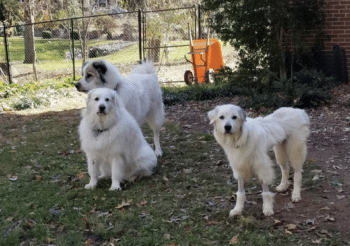
Optimus (standing back left), Rio (sitting left), and Merveille (right).
Many Davidsonians helped provide that love. Neighbors took time to pet her and give her treats. Students at the college did the same when meeting her on walks. Friends of her fosters visited her and brought more treats and toys. Merveille soaked in the attention and calories in equal measure!
By the middle of December Merveille weighed in at 46 pounds, and her follow-up blood work looked excellent. Dr. Reid was thrilled to see her, and Merveille walked into CVS like she owned the place and was showing off how much better she looked. [I have the picture with Dr. Reid taken at this visit if you want it.]
Many people who met Merveille in person or followed her story online wanted to know what happened to her. Stremlau explained that sometimes the organization knows a lot about the dogs they take into rescue, but other times “the dog’s history is a mystery. We know nothing about Merveille before she arrived at Randolph County animal control. We can make some educated guesses based on her behavior. For example, she’s house broken, and once she was able to control her bladder and bowels, she did not mess her Pyrpartment. She also understands where food is generally kept in a kitchen. That strongly suggests to us that she was someone’s pet and lived in a home.”
But whose? And how did she end up near death?
A post on CGPR’s Facebook page from January 8 provided some answers but also prompted more questions:
“We know almost nothing about Merveille’s background. Just the county in which she was found.
A kind supporter of the rescue offered to pay for a DNA test. We were game. Perhaps if we found relatives, we could learn where she came from and how she ended up in such distress.
We used an Embark Vet test because they identify breeds and genetic relatives. There are about 30 Pyrs who are half-siblings of Merveille. Several, including the late Fernando, came through our rescue. Many of the other dogs’ bios tell of being found in poor shape and taken in and placed by other rescues.
In other words, we are seeing a cluster that points to a backyard breeder who is creating a pattern of neglect and abuse. We are doing all we can to figure out who this person is. But that’s not the point of *this* story today.
Merveille has three DNA matches in their system so close that they are likely full siblings. In other words, these dogs all share the same parents but aren’t necessarily from the same litter. After messaging, we determined that one *probably* is a littermate of Merveille. This Pyr was found in Winston-Salem eating out of a garbage can as a puppy and was placed by Ruff Love.
Another of Merveille’s relatives, however, is her closest genetic match in Embark’s system. This dog is older than Merveille for sure, but because they share 46% of their DNA, they almost certainly share both parents. (In case you are confused that full siblings don’t share 100% of their DNA, we are all the products of genetic recombination from both parents, meaning identical twins aside, we share between 40 and 60% of our DNA with full siblings.)
And, unbelievably, that Pyr is…
……..Rio, her foster sister. Yup, Merveille’s foster sister is her *actual* sister. We had no idea!
We know very little about Rio’s past except that she was purchased as a puppy from a flea market in the Raleigh area. Through a guardian angel who stepped in and kept her from being rehomed on Craigslist when her first owner realized she couldn’t care for a Pyr puppy, Rio came to rescue the next month.
So, yeah, what are the odds?! Sisters!?
We are going to go play the lottery now!”
Although CGPR was already aware of this cluster of related dogs, as a result of Merveille’s story and subsequent emails with owners of these Pyrs, they now know that many (and perhaps most) of these nearly three-dozen dogs were found abandoned or taken to shelters in poor condition in counties in north central North Carolina. Owners turned to DNA tests for the same reason: to learn where their dogs came from. Stremlau said that they now have credible leads about who the likely backyard breeder is. They continue to gather information and will approach local news stations about covering the story when they have confirmed their findings.
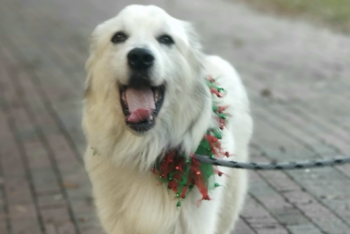
Merveille on her way to recovery – wearing some holiday “bling” for a walk around Davidson.
She emphasized that it is important to note that this person’s behavior isn’t illegal. Most backyard breeders in the Carolinas sell dogs at flea markets or store parking lots (especially big box and hardware stores), on Craigslist, and through social media. As Stremlau explained, “Unfortunately, neither Carolina regulates the sale of dogs or requires breeders to provide basic veterinary care to moms or pups. Our organization is not anti-breeding. In fact, we are grateful for those reputable breeders who are perpetuating the healthiest and best genetic lines. I want Pyrs to be here in a thousand years, and that means advocating for responsible breeding. Reputable breeders are volunteers and donors of ours. It is those who breed pups for profit and don’t care what happens to them who create the problems that we solve. And, really, this isn’t about breeding at all. It is about ensuring a basic quality of life and having standards of care for companion animals. If breeders were prohibited from selling puppies younger than 8 weeks old (when they can be vaccinated), had to provide proof of first vaccinations to owners, and could be held financially liable for selling dogs from lines with detectable and known health problems (puppy “lemon laws” are on the books in other states), the number of unwanted and abandoned dogs in our shelters would drop. Until we have laws that do this, we need people who love dogs to not give money to backyard breeders. If they aren’t making money, they will stop breeding dogs.”
As for Merveille, she no longer lives in Davidson. She was adopted the during first week of January by a family in the Triangle area who has had several Pyrs from CGPR over the years, including a male Pyr name Remi who is showing her the ropes of the household. Now named Roxie, she remains loved by her fosters and all who met her and were moved by her story. Stremlau promises that CGPR will continue to post updates.
If you see Rio and Optimus walking their humans around town, feel free to say hello! They are friendly and love everyone!
You can learn more about CGPR and Pyrs here:
Web page: www.carolinapyrrescue.com
Facebook: Carolina Pyr Rescue
Twitter: @CarolinaPyrs
Instagram: @carolinagreatpyreneesrescue, @optimuspyr, and @riograndepyrenees
YouTube: CarolinaGreatPyrs


